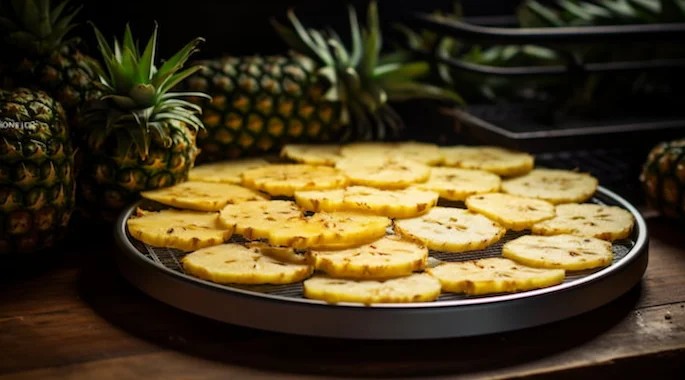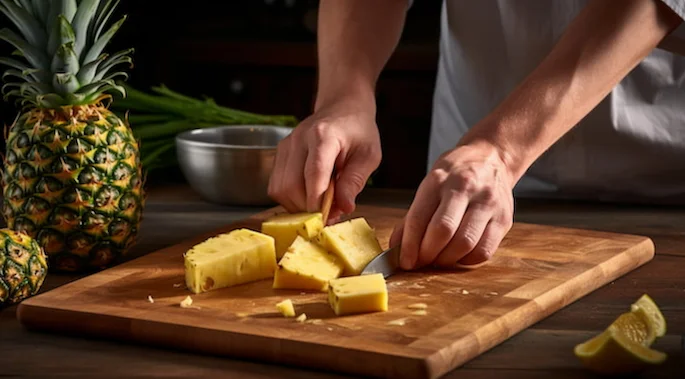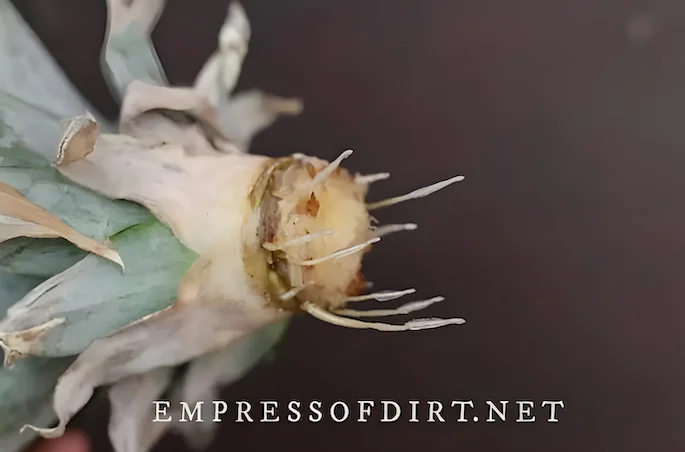What We Mean by “Dehydrate”
Here at Easy Food Dehydrating, “dehydrate” always means using an electric food dehydrator — the easy, reliable way to dry food at home.
- Home
- Dehydrating Fruits: Step-by-Step Guides by Type
- How to Dehydrate Pineapple
How to Dehydrate Pineapple – Fresh, Frozen, or Canned

How to dehydrate pineapple - whether it’s fresh, frozen, or canned - is easier than you think.
✅ Quick Answer: How do you dehydrate pineapple?
To dehydrate pineapple, slice it into ¼–½ inch pieces and dry at 125°F–135°F for 6–12 hours (up to 18 hours for thicker slices). Use fresh, frozen (thawed), or canned (drained) pineapple, and rotate trays to ensure even drying. Finished pieces should feel leathery, not sticky.
If you love pineapple and hate waste, dehydrating it is a smart, delicious way to preserve every juicy slice. This guide shows you exactly how to turn it into chewy, sweet snacks perfect for hiking, smoothies, or pantry storage.
We'll also cover how to reduce that mouth-tingling bromelain sting, how long to dry pineapple, and tips for rehydrating it when you're ready to enjoy it again.

In this guide, you’ll learn how to prep pineapple slices, reduce mouth irritation from bromelain, and get perfect drying results every time.
Pineapple Nutrition Info.
VITAMINS: Vitamin C and Vitamin B1 (also known as Thiamine).
MINERALS: Potassium, Manganese, Bromelain (digestive enzymes), Copper, and Folate.
Pineapple also packs a punch in the fiber department.
How Do You Know a Pineapple’s Ready to Slice?

Ready to slice up your pineapple? Look for golden skin, a sweet aroma, and leaves that pull out easily—these signs mean it’s ripe and ready to cut. Perfect for prepping slices before dehydrating!
Carefully cut off the crown and save it! Check out "Empress of Dirt" farther down the page on how to grow your own pineapples, indoors, using the top of the pineapple.
Begin by Using a Good Sharp Knife by Cutluxe!
Check out this great chef's knife with a full tang that means the handle and blade "are one" so they can't come apart when we're slicin' and a dicin'.
I know these Cutluxe Chef knives may be a little expensive, but they do last pretty much a lifetime when you maintain their cutting edges.
As an Amazon Associate, I earn from qualifying purchases — this does not affect the price you pay. Read full disclosure.
Get a Pineapple Corer!
I have a pineapple corer which you screw into the pineapple and out comes a long coil of pineapple, sliced into approx 1/2" thick overall.
So now we're ready to learn how to dehydrate pineapple!
As an Amazon Associate, I earn commission from qualifying purchases. The price you pay does not increase. Read disclosure here.
Step-by-Step: How to Dehydrate Fresh, Frozen, or Canned Pineapple
Step-by-Step: How to Dehydrate Fresh Pineapple
- Slice into 1/4" to 1/2" thick "rounds" or chunks, uniformly sized.
- If allergic to Bromelain, follow the instructions below.
- Place the pineapple on your food dehydrator trays.
- Turn on your dehydrator and set the temperature between 125°F and 135°F (or per your food dehydrator's instructions).
💡 Tip: Outside the U.S.? Most dehydrating temps here are listed in Fahrenheit - use our quick converter to see the Celsius equivalent for your machine.
- Drying time: between 6-12 hours and up to 18-hours using the above instructions.
- Dehydrated pineapple will feel leathery with no tackiness.
- Remember to rotate your food dehydrator trays, for even drying.
How to Dehydrate Frozen Pineapple (The Right Way)
The way to dehydrate frozen (pre-packaged) pineapple, is to simply allow it to thaw in the fridge for 24 hours (or at a minimum overnight).
Drain away excess pineapple juice/ice water in a sieve in the sink.
Follow the "fresh" steps 2 through 3 above, assuming your thawed pineapple has already been cut into uniform pieces.
How to Dehydrate Canned Pineapple in 3 Easy Steps
And for canned pineapple? Simply drain the excess pineapple juice from the can as you pour the canned pineapple into a sieve in the sink* and then follow "fresh" steps 2 through 3.
Also, the acidity in pineapple makes it great for tenderizing meats for use in marinades, and for sweet and sour dishes like teriyaki chicken, or pork.
*Many people save the canned juice and enjoy it as a beverage with a bit of sparkling water added to it. Also, use the left-over pineapple juice in your next smoothie!
Want to Rehydrate Dried Pineapple? Here’s the Simple Trick
To rehydrate dehydrated pineapple, simply soak the pineapple - preferably in its own juice - until it plumps back up. Give it about 30 minutes or so.
When using plain water, if you need - or want - to add a little sweetness back in, add a bit of sugar or honey to the water, before rehydrating your dried pineapple.
Sensitive to Pineapple’s Acidity? Try This Bromelain Hack
This just in from AhtonicusCruxzonicus AKA Papa’s Glorious Beard on Reddit:
Someone was saying that they didn't like the itch from the pineapple and what to do about it?
Here's AhtonicusCruxzonicus' response:
AhtonicusCruxzonicus says: I core, peel and slice them straight into an ice cold citric acid, honey and salt water bath for about 3 to 5 minutes to perk the flesh up, disrupt the bromelain enzymes that makes them itchy to the mouth, and keep them from turning dark. I also slice them a bit thicker 1/2 or so for a crunchy /chewy mouth experience.
by the way...
That "acidic" sting you are talking about is caused by the Bromelain in the pineapple. Bromelain is an enzyme that eats through the mucous coating on the inside of your mouth, then gets to work on the exposed proteins (which is why it's so good at meat tenderizing.) It’s kind of horrific, but doesn’t cause any permanent damage as long as you don’t continue to eat fresh-pineapple-after-fresh-pineapple like a crazy person without stopping. The enzyme affects some people a more harshly than others, so it’s entirely possible that some will never even notice it at all.
This article from Science Meets Food claims that the dissolved sodium chloride disrupts the enzyme’s polarity, which will “destabilize the protein and denature its structure.” Michael Tunick, Ph.D., an assistant clinical professor of culinary arts and food science at Drexel University in Philadelphia told Food & Wine that salt “triggers bromelain to begin working, so by the time the pineapple reaches your mouth, the enzyme has been inactivated,” and that “dipping fresh pineapple briefly in a saltwater solution is the best way to maximize contact between salt and bromelain.”
Why Is Dried Pineapple a Go-To Hiking Snack?

Dehydrated pineapple is much sweeter than fresh pineapple due to the water having been evaporated - it condenses the sweetness.
Don't overindulge in this candy-like fruit snack... I know it's tempting. Having said that, it's a great way to get some energy when you're out hiking in the great outdoors. Take dried pineapple along with you when you're backpacking!
Grow New Pineapples from the Top of a Store-Bought One
Here's how to cultivate a pineapple top and grow your own pineapples!
Simply visit empressofdirt.net and learn how to nurture roots to form on a pineapple crown.
Her Empress of Dirt website shares how to grow a pineapple indoors!
Your Pineapple Dehydrating Questions—Answered!
How long does it take to dehydrate pineapple?
How long does it take to dehydrate pineapple?
Slices ¼–½ inch thick take 6–12 hours at 125°F–135°F. If slices are thicker or humidity is high, drying can take up to 18 hours.
Can I use frozen or canned pineapple for dehydrating?
Can I use frozen or canned pineapple for dehydrating?
Yes! Thaw frozen pineapple overnight and drain well. For canned, drain juice thoroughly. Then dry as you would fresh pineapple.
How do I store dehydrated pineapple long-term?
How do I store dehydrated pineapple long-term?
Store in airtight containers and/or vacuum-sealed bags with oxygen absorbers and desiccant packs. Store in a cool, dark place for up to 12 months.
Why does pineapple make my mouth itch?
Why does pineapple make my mouth itch?
That’s bromelain at work—an enzyme that breaks down proteins. Soak pineapple slices in saltwater before drying to reduce that mouth-tingle.
Is dried pineapple good for hiking?
Is dried pineapple good for hiking?
Yes! It's naturally sweet, lightweight, and full of energy-boosting carbs—perfect for trail snacks or backpacking trips.
Thanks for stopping by to learn how to dehydrate pineapple the easy way!
From snack-ready slices to giving your smoothie a boost, pineapple really shines once it’s dried. And if you're hungry for more ideas, don't forget to download your free 5 Dried Food Recipes You'll Actually Love PDF (below) — including flavorful options like carrot soup, minestrone soup, split pea soup, spicy beef jerky, and banana cinnamon rolls.
Your dehydrator will be busy in the best way!
Get 5 Dried Food Recipes You'll Actually Love
Here's where you can get your copy of our all new
5 Dried Food Recipes (That Actually Taste Great)
They're my all-time favorite easy dried food meals!
Get it here right now.
For Free!
Before You Go...
If you enjoyed this page, tap the ❤️ in the lower right-hand corner.
It saves this page to your Grow bookmarks so you can find it again later.
You’ll also see quick share buttons to copy the link, post to Facebook,
or save it straight to Pinterest.



















